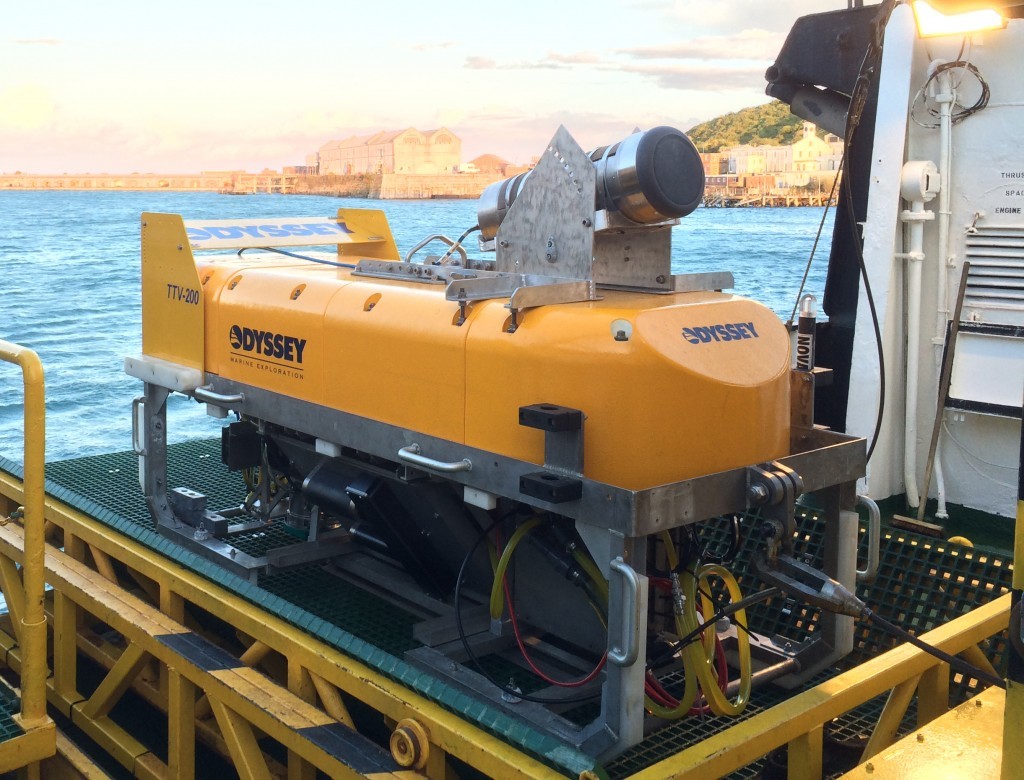
New subsea technology which could help in the search and salvage of deep water shipwrecks has been developed by a UK firm.
The new equipment, developed by Sonardyne, allows geophysical towfish to be tracked at distances far greater than current methods allow.
It has been successfully tested during trials in the Bay of Biscay by salvage specialists Odyssey Marine Exploration.
Odyssey are pioneers in the salvage of historic, deep water wrecks and rely heavily on side-scan sonars to identify potential targets. The towfish being used during the recent trial has been designed to their exact specification to enable far deeper depths to be explored.
Developed by UK company Sonardyne, the Ranger 2 GyroiUSBL system was able to track Odyssey Marine Exploration’s deep tow side-scan platform at a slant range of 7,500 metres from their vessel, Odyssey Explorer.
Only the depth of the north east Atlantic ocean prevented greater ranges being achieved.
Long layback tracking of towfish has traditionally always been a major challenge for conventional Ultra-Short BaseLine (USBL) acoustic positioning systems due to the very long slant ranges involved and vessel noise degrading performance.
Sonardyne first sought to address this challenge back in 2006, turning the problem on its head to create Inverted USBL (iUSBL).
In normal USBL operations, an acoustic transceiver is fitted to the survey vessel and an acoustic transponder is fitted to the target being tracked.
With iUSBL, their positions are swapped; the transceiver is installed on the towfish looking up at the transponder deployed from the vessel. The net result is that the signal-to-noise ratio is dramatically improved which in turn, allows long ranges and greater precision to be achieved.
The new Ranger 2 GyroiUSBL system builds on this technique by exploiting the long term accuracy and precision of acoustic positioning with the continuous availability and fast update rate of high-grade inertial navigation sensors.
Sonardyne projects manager Tom Bennetts, said: “All USBL transceivers require motion compensation, whether vessel-based or installed on a towfish. Typically this requires an attitude and heading reference sensor to be co-located with the transceiver, which is both complex and time consuming to correctly align.”
“Inside our GyroiUSBL, we have combined the features of our sixth generation HPT acoustic transceiver technology with SPRINT, a subsea INS that can result in more
than 10 times improvement in positioning precision over USBL alone.
“Combing both instruments into a single titanium housing depth rated to 7,000 metres enables organisations like Odyssey to quickly and efficiently mobilise deep tow technology without having to worry about navigation sensor offsets.”
For the test, Odyssey used a high-powered directional Wideband Mini Transponder (WMT) in responder mode mounted to an over-the-side deployment pole from the Odyssey Explorer. This was interfaced via control room hardware to the GyroiUSBL transceiver mounted on the towfish. Power and communications to the GyroiUSBL was provided through a Nexus multiplex fibre optic telemetry system.
With the towfish fully deployed, Odyssey used the GyroiUSBL to passively listen for the WMT’s signal in a low noise, dynamically stable subsea environment. This meant that they were able to accurately track the position of their towfish at a previously unachievable slant range of 7,500 metres.
“The trial went exactly to plan,” said Bennetts. “As the layback grew and grew, GyroiUSBL just kept tracking until the ocean depth became prohibitive. Analysis of the signal-to-noise data at the time indicated that we could have tracked to beyond 9,000 metres had the winch cable been able to extend further.”
Speaking about the positive results of the tests, Andrew Craig, Senior Project Manager at Odyssey Marine Exploration said, “”The positions acquired via the GyroiUSBL system have allowed for a great reduction in operational time spent locating and inspecting subsea targets. We look forward to pushing the capabilities of the system to its limits during future projects.”